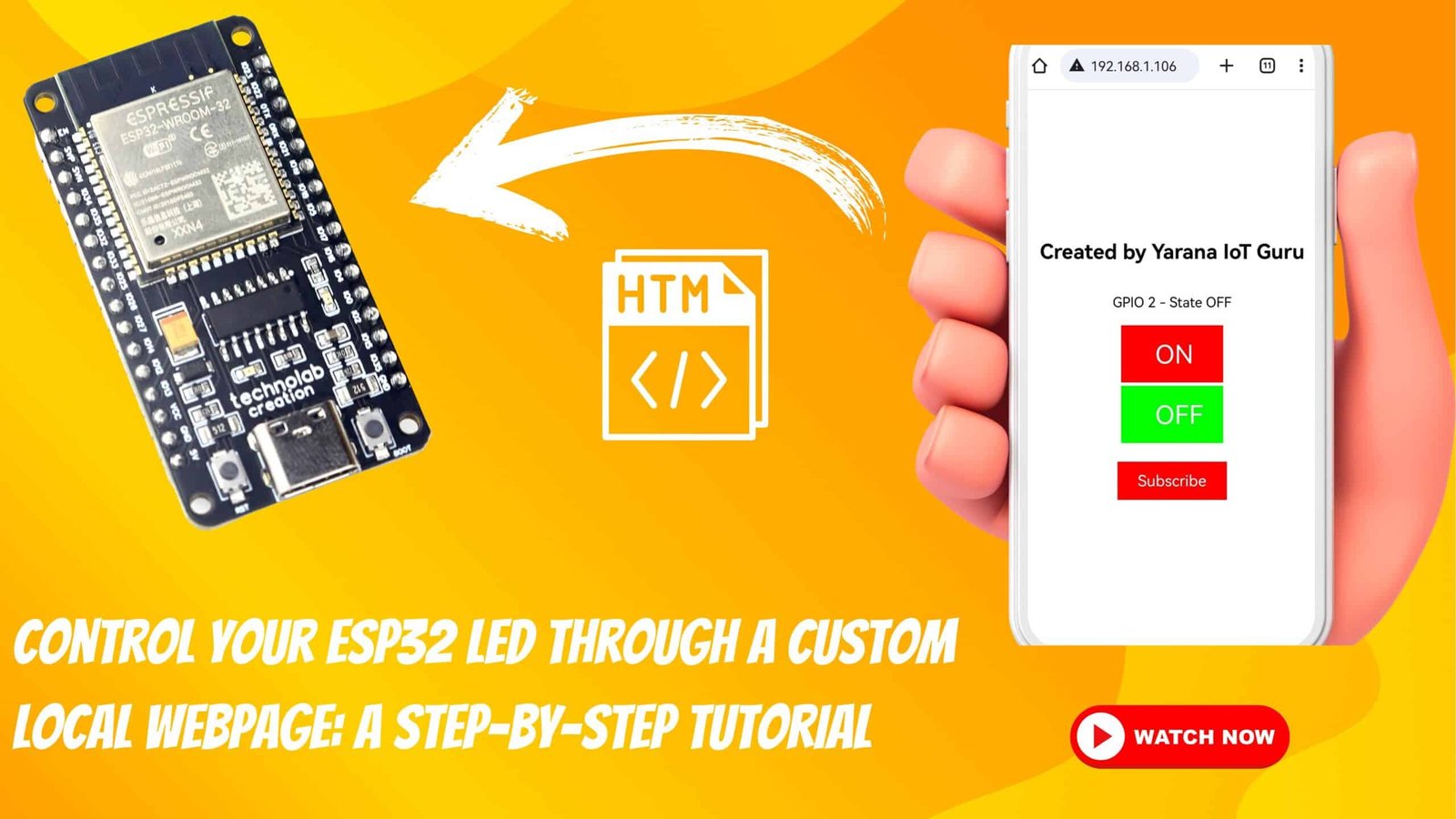Welcome to Yarana IoT Guru! 🌟
Are you tired of re-uploading code every time you want to change the WiFi credentials on your ESP32? What if you could change your ESP32’s WiFi connection dynamically using a web dashboard?
In this guide, you’ll learn how to build an ESP32 WiFi configuration dashboard that lets you:
✅ Change WiFi credentials without re-uploading the code
✅ Manage and switch between different networks dynamically
✅ Use AsyncWebServer and WebSockets for real-time updates
👉 📥 Download Complete Code:
🔗 ESP32 WiFi Config Dashboard GitHub Repo
🎯 What You Will Learn in This Guide?
✔️ How to set up a dynamic web dashboard for ESP32 WiFi management
✔️ Using AsyncWebServer and WebSockets for real-time data updates
✔️ Step-by-step ESP32 code walkthrough for seamless WiFi configuration
✔️ Live demonstration of changing WiFi networks on ESP32
🛠 Tools & Technologies Used
✅ ESP32 Microcontroller – The brain of our project
✅ AsyncWebServer – For creating a web-based dashboard
✅ WebSockets – For real-time two-way communication
✅ SPIFFS (SPI Flash File System) – For storing WiFi credentials
✅ HTML/CSS & JavaScript – For building the interactive web interface
📌 Why Do You Need a Web-Based WiFi Configuration Dashboard?
Usually, ESP32 stores WiFi credentials inside the code, requiring you to reprogram it every time you change networks. This can be a major inconvenience in IoT projects.
By using a web-based dashboard, you can:
🔹 Change WiFi settings easily from any device (mobile, laptop, etc.)
🔹 Save WiFi credentials in SPIFFS (so they persist after reboot)
🔹 Improve user experience in IoT projects
🚀 Step-by-Step Guide to ESP32 WiFi Configuration Dashboard
Step 1: Setting Up the ESP32 Development Environment
Before we start, ensure you have:
✔️ Arduino IDE installed with ESP32 board support
✔️ AsyncWebServer library and WebSockets library installed
✔️ An ESP32 board
📥 Required Libraries
Install the following libraries from Arduino Library Manager:
nginxCopyEditESPAsyncWebServer
ESPAsyncTCP
FS
SPIFFS
ArduinoJSON
Step 2: Uploading the Web Files to ESP32 (SPIFFS)
Since we want the WiFi configuration page to be accessible via a web browser, we will store HTML, CSS, and JavaScript files in SPIFFS.
To do this:
- Install the ESP32 SPIFFS Uploader Plugin
- Store the HTML, CSS, and JavaScript files inside the /data folder
- Upload the files using the ESP32 Sketch Data Upload tool
This ensures that the dashboard is stored inside the ESP32’s flash memory, making it accessible even after a reset.
Step 3: Writing the ESP32 WiFi Management Code
Below is a simplified version of the code to handle WiFi credentials, WebSockets, and SPIFFS storage:
1️⃣ Load Saved WiFi Credentials
cppCopyEdit#include <WiFi.h>
#include <FS.h>
#include <SPIFFS.h>
String ssid = "";
String password = "";
// Function to load saved WiFi credentials from SPIFFS
void loadWiFiConfig() {
File file = SPIFFS.open("/wifi_config.txt", "r");
if (!file) {
Serial.println("Failed to open WiFi config file.");
return;
}
ssid = file.readStringUntil('\n');
password = file.readStringUntil('\n');
file.close();
}
2️⃣ Connect to WiFi Automatically
cppCopyEditvoid connectToWiFi() {
WiFi.begin(ssid.c_str(), password.c_str());
Serial.print("Connecting to WiFi...");
int attempts = 0;
while (WiFi.status() != WL_CONNECTED && attempts < 20) {
delay(1000);
Serial.print(".");
attempts++;
}
if (WiFi.status() == WL_CONNECTED) {
Serial.println("\nConnected to WiFi!");
} else {
Serial.println("\nFailed to connect.");
}
}
3️⃣ Handle WiFi Configuration from the Web Dashboard
cppCopyEdit#include <ESPAsyncWebServer.h>
AsyncWebServer server(80);
void setupServer() {
server.on("/", HTTP_GET, [](AsyncWebServerRequest *request) {
request->send(SPIFFS, "/index.html", "text/html");
});
server.on("/setWiFi", HTTP_POST, [](AsyncWebServerRequest *request) {
String newSSID = request->arg("ssid");
String newPassword = request->arg("password");
File file = SPIFFS.open("/wifi_config.txt", "w");
if (file) {
file.println(newSSID);
file.println(newPassword);
file.close();
request->send(200, "text/plain", "WiFi settings saved! Rebooting...");
delay(2000);
ESP.restart();
} else {
request->send(500, "text/plain", "Failed to save WiFi settings.");
}
});
server.begin();
}
Step 4: Testing & Demonstration
1️⃣ Upload the code to your ESP32
2️⃣ Connect to the ESP32’s Access Point (if not connected to a router)
3️⃣ Go to the Web Dashboard (IP address displayed in Serial Monitor)
4️⃣ Enter New WiFi Credentials and save
5️⃣ ESP32 will reboot and connect to the new network
✅ Congratulations! You have successfully created a dynamic WiFi configuration dashboard for ESP32. 🚀
📺 Watch the Full Video Tutorial
🔴 ESP32 WiFi Configuration Video on Yarana IoT Guru
📢 Check out our GitHub Repo for the full source code!
👉 Download Code
📌 Frequently Asked Questions (FAQs)
❓ Can I use this method on ESP8266?
✅ Yes! The concept is similar, but you need to modify the libraries for ESP8266.
❓ How do I reset WiFi credentials?
✅ Simply go to the dashboard and enter new WiFi details.
❓ What if ESP32 fails to connect to WiFi?
✅ It will switch to Access Point mode, allowing you to reconfigure WiFi.
🚀 Final Thoughts
This ESP32 WiFi Configuration Dashboard is a powerful feature for any IoT project. It allows users to dynamically change WiFi settings without re-uploading the code, making IoT deployments much easier.
✅ Try this project and take your IoT skills to the next level!



